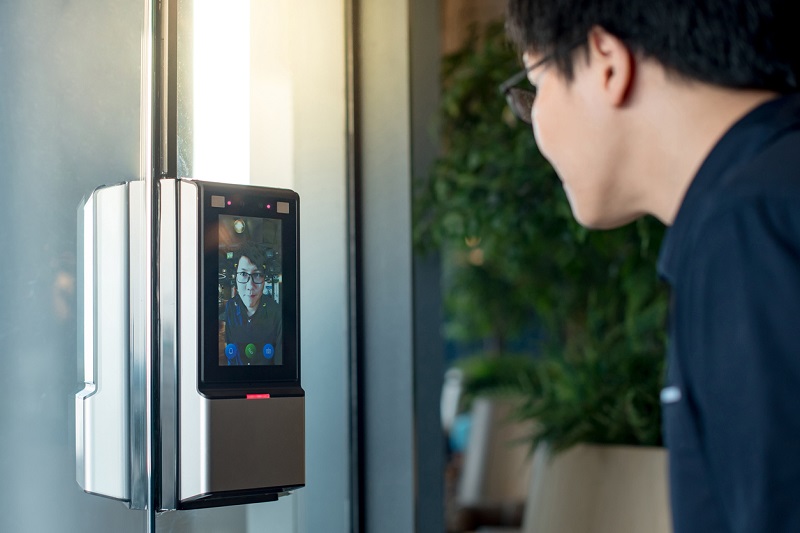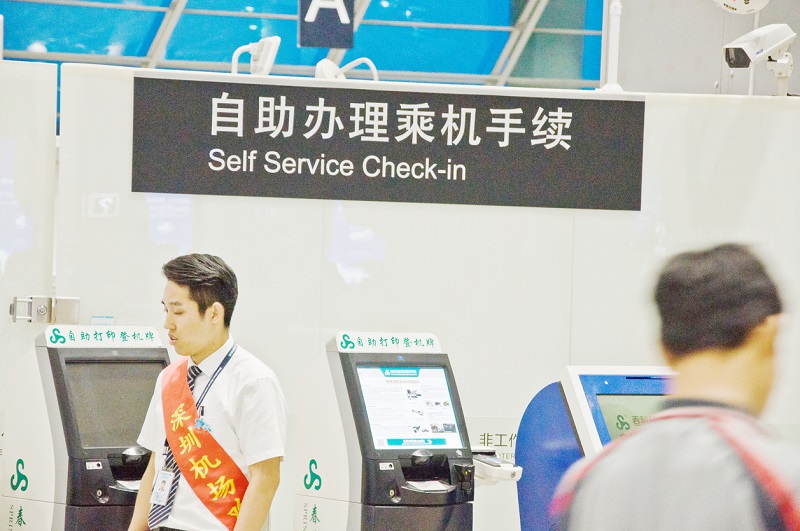Facial recognition has been utilized as a way to enhance security for decades, but what was once a very costly technology, accessible mainly by the military and other extremely large organizations, has now become quite common. For instance, many smartphones, like the iPhone, have used facial recognition for several years, and it is now being integrated to assist with a wide variety of other tasks, too. Today, we will discuss facial recognition technology and its benefits.
What is a facial recognition kiosk?
Facial recognition kiosks utilize a specialized camera and software that, when used together, are able to detect and recognize known users. Facial recognition technology can be used in a variety of applications, ranging from retail to facilities management. As facial recognition technology continues to improve and become less cost prohibitive, it will provide many businesses with an important way to more efficiently process visitors and transactions, while offering more convenience and a better experience for the end user.

Why use facial recognition kiosks?
While facial recognition kiosks have been growing in popularity for a number of years as a matter of convenience, the need for contactless forms of facilities and visitor management, as well as no- and low-contact transactional kiosks, has been exacerbated by the COVID-19 pandemic. Facial recognition allows the identity verification which can be useful not just for unlocking cell phones, but also for building access control in businesses or schools, event ticketing, or making retail transactions more secure.
Security
Businesses with physical locations will always have building security front-of-mind. Traditional security measures have historically required a manned station during business hours, if not ‘round-the-clock. Even during regular times, but especially during the pandemic, keeping security staff in place 12+ hours per day can be impractical, or even dangerous -- not to mention expensive.
It’s therefore easy to see why facial recognition kiosks have become popular; with fewer staff required on premise to supply security, it’s easy to reduce overhead and risk at the same time. In addition, these kiosks can identify not just authorized individuals, but also VIPs, alerting facilities managers and other relevant staff to their arrival.
Faster processing
As kiosks are essentially specialized computers, they are able to compute and process information at a much faster rate than humans. For busy environments, a facial recognition kiosk is able to process individuals much more quickly, reducing wait time significantly. This means that even during the busiest times of the day, queues will move quickly, keeping users happy.
Convenience
Facial recognition kiosks are often quite convenient for customers, employees and visitors, as they don’t require an attendant. By automating check-in or transactional processes, line volumes are reduced, providing users with a much more pleasant experience.
Facial recognition kiosks are also convenient for the organizations that deploy them. By quickly and easily identifying and recording anyone who enters a building, it saves businesses time, while offering incredible accuracy and consistency compared with a physical agent.
Ease of Use
A facial recognition kiosk works by using a camera to detect and locate specific areas of the face, which is then compared to an existing database. Recognition software reads the “facial geometry,” using facial “landmarks” such as eye sockets, chin, cheekbones and lip contours to distinguish the face being analyzed in comparison to a database of other faces, which could number in the thousands, or even millions. The process is automated and extremely fast, with little to no learning curve for those accessing the system.
No- or Low-Contact
Many digital kiosks are designed to be low- or no-contact, which has been a key reason for their adoption by many organizations, especially during the COVID pandemic. Kiosks, like those intended for facial recognition and security needs, ensure that businesses can continue to operate efficiently while keeping their staff and guests safe.
How does a facial recognition kiosk work?
There are a number of steps required in order for a kiosk to identify individual faces accurately:
Facial Detection
The camera takes a photo of the user’s face and compares it to another facial photo taken in full profile.
Facial Analysis
After the image or images are taken, the software analyzes the facial geometry shown in the photos, noting key elements such as the distance between both eyes, chin shape and depth, and size and location of the cheekbones. Other distinguishing facial features are also examined.
Image Conversion to Data
Once the image is analyzed, the software then converts the picture into data, creating a numerical code for future use -- essentially creating a one-of-a-kind “faceprint.” This functions similarly to a thumbprint in that both are unique.
Data Matching
As a final step, the unique faceprint is compared to a database of known faces, which may include any combination of employees, contacts, visitors, guests or customers, depending on the kiosk’s intended use. Once an individual’s information is recorded in the database, they are then able to bypass traditional security measures and enter the facility without further delay.
Common use cases for facial recognition kiosks
For many organizations, facial recognition provides an accurate means of tracking and recording exactly who is in a given building or area. Below are examples of industries that currently utilize facial recognition technology.

Large or Security-Sensitive Organizations
Many traditional forms of building and facilities management have become obsolete or impractical, especially for very large organizations or those for which security is a very high priority. Facial recognition kiosks ensure that an individual is who they claim to be, while restricting access for unknown persons.
Airports and Border Control
Airports and border control facilities require heavy security, but these security measures can also be time consuming as individually checking each visitor requires a great deal of manpower. Facial recognition kiosks assist the staff on hand by providing a secondary means of confirming the identity of an individual. Visitors allow the camera to take their image, then the kiosk identifies the person so that the staff can determine whether they should be allowed to proceed through the secure checkpoint.
Law Enforcement
Law enforcement has utilized facial recognition technology for many years to assist with solving crimes. With a compiled database of known persons of interest, law enforcement around the world can use facial recognition software to quickly identify a suspect, even if they appear in a new location.
Banking and Financial Services
Banks have begun to utilize facial recognition software in addition to PIN numbers to create secure accounts for users. This is most common among ATMs or Bitcoin and cryptocurrency kiosks. This is to help protect against fraud or tampering with another individual's account.
Purchasing, Ticketing and Dispensing
Many businesses have employed facial recognition software to allow for contactless payments and item dispensing, as well as to bolster security and combat theft.
Healthcare
Hospitals are beginning to utilize facial recognition to confirm patient identity. This technology can also be used to confirm the identity of physicians or nurses to help prevent medical errors.
Companies using facial recognition
Many companies have already begun adopting facial recognition technology. Here are some of the more notable examples of how businesses have integrated this technology into their operations.
Amazon
Perhaps one of the most prominent adopters of facial recognition technology, Amazon has developed a product called Amazon Rekognition to quickly identify individuals in an image or video. The software provides highly accurate facial analysis and facial search capabilities that can be used to detect, analyze, and compare faces for a wide variety of applications, including user verification, people counting, and public safety. Rekognition is part of Amazon’s web services (AWS) division.
Macys
Macys has adopted facial recognition technology to help combat crime in stores that experience high levels of organized theft via repeat offenders.
Apple
Apple has predominantly utilized facial recognition software as part of the operating systems for their smartphones and tablet computers in order to allow users to quickly unlock their personal devices.
Caliburger
The California-based fast food chain uses facial recognition in order to better tailor the ordering and in-store experience to their customers’ preferences. This allows loyalty members to save payment and past-order information so that they no longer have to physically swipe to pay future orders.
Facial recognition kiosks can be excellent assets to many organizations, providing greater convenience for both the user and those deploying them. While the technology does have drawbacks, the benefits often more than justify most concerns.


